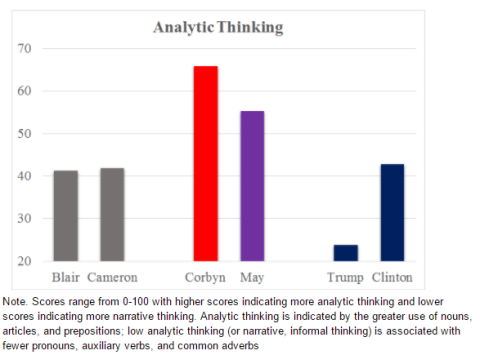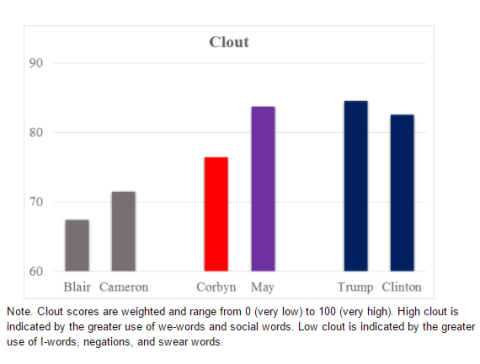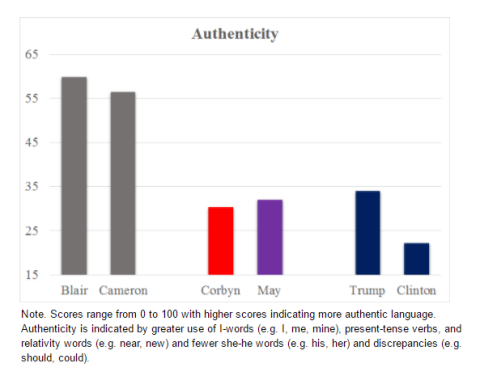May versus Corbyn: A Look into the UK’s Election
June 5, 2017
Kayla N. Jordan
University of Texas at Austin
Kavita Vedhara and Pamela Pepper
The University of Nottingham
Less than 2 months ago the UK’s prime minister, Theresa May, made the unexpected decision to hold a snap election. The elections will take place this week and has ostensibly been called in response to division in Westminster that she believes threaten future Brexit negotiations. As the UK begins the process of leaving the EU, the voters are expected to elect a leader from one of the two main parties in the country: the Conservatives led by Theresa May and the Labour party led by Jeremy Corbyn. After the surprising Brexit vote and U.S. election of Donald Trump, elections around the world have drawn attention for growing populism and isolationism. So as election day grows closer, we look at what the language of May and Corbyn reveals about them and the types of leaders they may be.
While Theresa May refused to take part in traditional debates, both May and Corbyn participated in three Q&A events interacting with both media figures and regular voters. These took place between May 22 and June 2 and will be the basis for our analysis. Furthermore, to put this in context we compare these Q&A events to pre-election interviews by recent prime ministers, Tony Blair and David Cameron, as well as to the 2016 general election debates between Donald Trump and Hillary Clinton. Specifically, we look at how these candidates compare on three dimensions: thinking style, clout, and authenticity.
Thinking Style
When trying to better understand political candidates, one interesting facet to consider is their thinking style. Do they approach problems in an analytic, logical way or are they more intuitive and narrative in their style? In recent American politics, Donald Trump has stood out as being an exceptionally intuitive, informal thinker both as a candidate and as a president. So where do the current British candidates stand on this measure?
Between the two candidates, Theresa May is less analytic than Jeremy Corbyn. However, both are more analytic than recent British prime ministers, Tony Blair and David Cameron, as well as recent U.S. presidential candidates, Donald Trump and Hillary Clinton. While May lays out her ideas in a somewhat simpler fashion compared to Corbyn, no matter who wins the election, the next British prime minister is likely to have a different thinking style than recent UK prime ministers and a vastly different style to the current American president, Donald Trump.

Confidence and Clout
Another interesting facet of political leadership is how confident they are. We know from past research that those who confident and high status tend to use more we-words (e.g. we, our) and social words (e.g. friend, ally, group) while using fewer I-words (e.g. my, mine), negations (e.g. no, not, never), and swear words. Since calling for the election when she had relatively high levels of support, Theresa May has seen the election become very close with some polls suggest that the gap between Labour and Conservative is shrinking. So has the narrowing of the polls impacted either May or Corbyn’s confidence?
Despite the slides in the polls, May has remained more confident than Corbyn. Over time, May’s confidence has remained stable while Corbyn became more confident as election day draws closer (70.6 to 75.5). However, it is interesting to note that compared to previous UK prime ministers, both May and Corbyn are more confident in talking about the issues they face. May, in particular, resembles recent American candidates more than past British PMs.

Authenticity
A final dimension worth looking at is authenticity. When confronted with questions, are the candidates sincere and straightforward or evasive and impersonal? Authentic individuals tend to use more I-words, present-tense verbs, and relativity words (e.g. old, far, here) and fewer she-he words and discrepancies (e.g. could, should). So how do May and Corbyn compare?
Both May and Corbyn are relatively inauthentic particularly compared to recent PMs, Blair and Cameron. When faced with difficult questions such as broken promises by May or IRA connections with Corbyn, both candidates have sounded evasive and distant. Interestingly, May and Corbyn are quite similar to Donald Trump when it comes to authenticity.
Throughout his campaign and after his election, Trump generally came across as a authentic and personal (even if he was often objectively incorrect). However, during the general election, following the scandal with the leaked Access Hollywood tape, Trump was less authentic in the later debates. While not so extreme, both May and Corbyn also have criticisms they have to endure and these appear to have impacted their authenticity during these events.

The Big Picture
So what do we know about the two major candidates, Theresa May and Jeremy Corbyn? May is a more intuitive thinker and more confident in her position but relatively inauthentic. Corbyn is also relatively inauthentic, but is much more of an analytic thinker; and while he is showing less confidence than may, this is growing. While in U.S. elections intuitive and confident individuals tend to do better in elections, the situation and electorate in the UK could favor a different type of candidate so we shall have to wait to see whether the more confident, intuitive May will be victorious or the more analytic, increasingly confident Corbyn will prevail.
No matter which candidate ends up as prime minister it is interesting to note that the next British prime minister will be a departure from other recent PMs. Compared to Blair and Cameron, May and Corbyn are both more analytic, more confident, and less authentic than their predecessors. In fact when it comes to confidence and authenticity, May and Corbyn are more like their recent American counterparts, Donald Trump and Hillary Clinton, than recent British PMs. While there are obvious difference between May and Corbyn, they both are likely to be different types of leaders than their recent predecessors.
Helpful Resources:
Newman, M. L., Pennebaker, J. W., Berry, D. S., & Richards, J. M. (2003). Lying words: Predicting deception from linguistic styles. Personality and social psychology bulletin, 29(5), 665-675.
Kacewicz, E., Pennebaker, J. W., Davis, M., Jeon, M., & Graesser, A. C. (2014). Pronoun use reflects standings in social hierarchies. Journal of Language and Social Psychology, 33(2), 125-143.
Pennebaker, J. W. “The secret life of pronouns: How our words reflect who we are.” New York: Bloomsbury (2011).
Pennebaker, J. W., Boyd, R. L., Jordan, K., & Blackburn, K. (2015). The development and psychometric properties of LIWC2015. liwc.net
Pennebaker, J. W., Chung, C. K., Frazee, J., Lavergne, G. M., & Beaver, D. I. (2014). When small words foretell academic success: The case of college admissions essays. PloS one, 9(12), e115844.
March 7, 2019 at 1:30 pm
[…] por ejemplo. Del mismo modo, Gordon Brown tenía un habla más compleja que la de David Cameron. Y Jeremy Corbyn expresa mayor pensamiento analítico que Theresa May, como Hillary Clinton frente a Trump. Dos de los políticos que manejan un lenguaje más […]